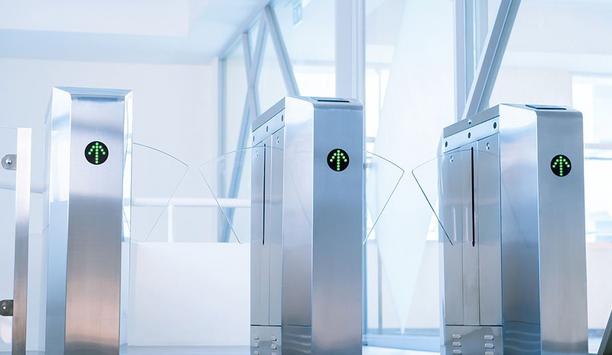COVID-19 impacted nearly every industry virtually overnight, and the security sector was no different. It challenged us, as a society, to rethink how we view security entirely, and expanded the scope of security from protecting physical and digital assets to promoting safer, healthier, and more efficient environments in every context.
Now, as we progress through 2021, keeping people safe has become even more of a priority as workers begin heading back to the office. Businesses are evaluating how they can prioritize the security, health, and safety of their people as they invite employees, visitors, and customers back inside.
Technology is the solution
The solution to this problem, as it is to many others, is technology. Innovations in tech can help businesses address threats and stay ahead of the curve in a world in which we’ve come to expect a higher standard of safety. The use of technologies such as touchless doors, workflow management systems and health screenings will continue to be essential in the post-COVID workplace.
There’s also contact tracing, environmental monitoring and advanced visitor management, which are all useful tools that can be implemented to help protect and reassure employees ahead of their return to work. With these, and even more advances in development, technology will continue to be central to security. This industry isn’t just locks on doors – it’s about integrated and innovative tech.Essentially, we need tech-savvy people in every part of the business
Of course, these new security solutions need tech talent in the form of innovators, engineers, installers and many more roles. Essentially, we need tech-savvy people in every part of the business. They are the ones developing new, intelligent solutions and they’re also the ones out in the field, making our work, home, and public environments safer, healthier, and more efficient.
For us, the tech transformation has already happened, but it’s an ongoing challenge, across our industry and others, to find tech talent at the rate of innovation. Once you start a tech transformation, the need for talent snowballs.
The tech talent shortfall is real, and it’s not going away soon
The problem is, while the demand for security tech has never been greater, tech talent is increasingly scarce. This was the case even before COVID-19. We’ve known for a while now that the talent population is shrinking. There’s clear evidence to back this up too: There are millions of jobs around the world that remain unfilled because people lack the relevant skills, and a lot of these jobs are in tech. In the latest CIO Survey by KPMG, more than half surveyed said that hiring challenges were harming the industry. The tech talent shortage is real, and there’s no imminent solution in sight.As remote work became commonplace, industries were suddenly forced to compete for tech talent with top firms worldwide
COVID-19 has only widened the talent gap. Many companies had to rapidly accelerate their digitization efforts to function during lockdown, so the tech talent on the market was quickly snapped up. Additionally, while waves of furloughs and layoffs flooded the market with skilled talent throughout 2020, this led to a unique challenge: fierce competition across the globe to attract talent that was, in many cases, no longer bound by their geographic location. So, as remote work became commonplace and opened new doors for potential job candidates, it also further exacerbated the talent shortage for industries that were suddenly forced to compete for tech talent with top firms worldwide.
When businesses can’t find the skills they need readily available, the only option is to train existing staff and new, under-skilled recruits. At a time when we couldn’t meet face-to-face, this became much more difficult. Companies had to work out how to train, recruit, and onboard employees remotely and many simply didn’t have a process in place for this. As a result, the tech talent shortfall continued to grow.
Mapping the solution to the tech talent shortage
So, what can we do? Ultimately, the private sector needs to become actively involved in developing solutions to address the problem. There are many ways of doing this too. First, businesses can create more entry-level positions that offer employees the opportunity to gain the hands-on training and education needed to grow. Implementing a high-quality training program is critical to employees’ professional development, especially in remote environments that don’t offer the same amount of face-to-face experience that often helps during the onboarding process.At STANLEY Security, we have launched international scholarships to provide opportunities for young people to develop the vocational and trade skills
Second, partnering with schools, associations, and governments to develop scholarship and apprenticeship programs is key to creating a sustainable pipeline of talent. It’s not just about finding talent, but creating it too. At STANLEY Security, we have launched international scholarships to provide opportunities for young people to develop the vocational and trade skills needed both today as well as in the future.
Our apprenticeship program also offers invaluable opportunities for technicians to collaborate with mentors and gain hands-on experience with security technologies. Both of these programs are key initiatives STANLEY Security has implemented to help address the talent shortage.
Then there’s upskilling of your current workforce. We found that plenty of our existing employees in non-tech roles were eager to learn new tech skills, meaning they could be retrained while continuing to work, taking on more of a tech role as we nurtured their skills. This has been invaluable in enabling our own tech transformation and has helped get us to where we are today. There’s certainly a tech talent shortage, but there’s no shortage of people who are open to training opportunities if they have the chance. It’s up to businesses now to provide that training, for the benefit of the company and its employees.
Like many others, the security industry has rapidly evolved, and we’ve seen new challenges and opportunities arise. Technology – and the talent that develops and implements it – is our best resource to help make environments safer, healthier, and more efficient in a post-pandemic world.
Demand for tech talent isn’t going to go away, nor can we ignore the problem. As businesses, we need to face the challenge head on and quickly work to find solutions. That could mean creating more entry-level positions, offering scholarships and apprenticeships, and upskilling our most valuable asset – our people. At the end of the day, we need to empower people with the skills, knowledge, and experience they need to design solutions that can help us face the challenges of the future.





























